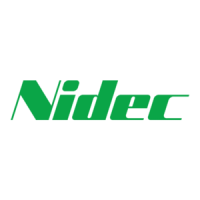What causes bus under voltage during running of Nidec DC Drives?
- CChad FergusonSep 4, 2025
A bus under voltage during the operation of Nidec DC Drives is caused by power grid low voltage, so check the input power source.

What causes bus under voltage during running of Nidec DC Drives?
A bus under voltage during the operation of Nidec DC Drives is caused by power grid low voltage, so check the input power source.
What to do if Nidec NE300-4T0300G/0370P show ground fault?
If your Nidec DC Drives are indicating a ground fault, it could be due to a short circuit in one of the output phases. Check whether the electric motor insulation is weakening. Also, check whether the wiring between the frequency converter and the electric motor is damaged.
What to do if Nidec NE300-4T0300G/0370P show load short-circuit?
If your Nidec DC Drives are displaying a load short-circuit error, check whether the electric motor coil is short circuit. If the inverting module IGBT is damaged, ask for the services from manufacturers.
What to do if Nidec NE300-4T0300G/0370P show output phase loss?
If your Nidec DC Drives are showing an output phase loss, check the U-V-W motor wiring. Also, if there is a serious unbalance in output, check the load.
What to do if Nidec NE300-4T0300G/0370P show input phase loss?
If your Nidec DC Drives are indicating an input phase loss, it means the input RST has phase loss or imbalance, so check input voltage.
Critical warnings and cautions for using the drive in various applications.
Cautions and warnings related to the physical installation of the drive.
Essential warnings and cautions for electrical wiring of the drive and peripherals.
Warnings and cautions to ensure safe operation of the drive.
Safety precautions for maintaining and inspecting the drive components.
Detailed technical specifications covering control features, communication, and protections.
Important notes and precautions for power supply and motor wiring.
Procedure for navigating and modifying function codes in the drive menu structure.
Parameters for configuring start/stop modes, DC braking, and acceleration/deceleration.
Configuration of digital and analog input terminals for control.
Detailed description of parameters for starting and stopping the drive.
Detailed description of parameters for vector control operations.
Detailed description of parameters for V/F control.
Detailed description of parameters for motor configuration.
Detailed description of parameters for digital and analog input terminals.
Detailed description of parameters for PID control.
Detailed description of protection and fault parameters.
Detailed description of protection parameters.
Table of trip codes, types, possible causes, and solutions for drive faults.
Troubleshooting guide for common abnormal situations.
Guidelines for regular inspection of operating environment and drive components.
Schedule for periodic inspection of drive and motor components.











